James Warren, a frequent public bus rider in Denver, noticed a significant problem: many bus stops lacked seating. Particularly on a cold morning in January, Warren observed a woman waiting for a bus, with no seating available at the stop and no sidewalk, forcing her to sit in the dirt. Motivated by this sight, Warren took scrap (废料;废品) wood from construction waste bins and set out to construct a bench.
This singular act of kindness evolved into a larger mission when he realized that one bench was far from enough. In the Denver metro area alone, there are more than 9, 000 bus stops, many of which lack seating or shelter. To add a personal touch and spread a message of compassion, he carved “Be kind” into each bench, symbolizing the spirit of the project.
Warren’s initiative resonated with the community, especially among those who benefited daily from the benches. “I met some ladies the other day who talked about how they used the benches every day. It fills me up. It’s air in my tires.” Warren recalled. His enthusiasm increased as more people joined his bench-making efforts. “I’ve had a lot of people reach out to me on Twitter,” he mentioned. “Some people have wanted to come and help me.” Inspired by Warren’s work, others in the local news audience decided to contribute as well, with many donating supplies. “That puts me over the moon,” Warren expressed.
Nica Cave, a 26-year-old mobility advocate (改善交通运输系统的倡导者) from Denver, emphasized the wider impact of the initiative. “The absence of proper infrastructure, shelter, and seating at transit stops, such as bus stops and train stations, disadvantages those who rely on public transportation. People like Warren are encouraging, showing how individuals are willing to use their own time and resources to provide these much-needed services.”
Warren envisions extending his project beyond simply providing benches. He plans to create a bench-building workshop to foster community engagement and support. His ultimate goal is to enhance the quality of life in his community and inspire similar actions elsewhere, emphasizing that small acts of kindness and effort can load to significant improvements in daily experiences.
1. What are Warren’s benches at the bus stops made from? (no more than 6 words)2. How do you understand the underlined part in Paragraph 3? (no more than 10 words)
3. Why did Warren feel happy? (no more than 15 words)
4. What does the last paragraph mainly talk about? (no more than 10 words)
5. What can you learn from the story? Please explain in your own words. (no more than 20 words)
Rembrandt Harmenszoon was born in the Netherlands in the city of Leiden. There were six children in his family. His parents wanted him to get a good education and provided opportunities for him to study with successful painters. Among them was the famous painter, Pieter Lastman in Amsterdam.
Rembrandt was very talented and studied with Lastman for six months and then moved back to Leiden and began to teach other artists even though he was only 22 years old.
Sometimes he used members of his family as models. His father was the subject of Bearded Man in Furred Oriental Cape and Robe. His son Titus is seen in Titus at His Desk, and Prodigal Son in the Tavern features Rembrandt and his wife Saskia.
One of his most famous paintings is Nightwatch which shows a group of men in their military uniforms. A war had recently ended in the country and the men were dressed up for a military practice. Nightwatch was a controversial(有争议的) piece. Some of the people in the painting were not pleased with the results because they did not have a prominent(突出的) place in the picture. When Rembrandt painted it, the colors were bright, but it became clouded with smoke and dirt and eventually became known as Nightwatch. In this painting we see Rembrandt’s use of light and shadow which makes his work so distinctive.
This great Dutch artist was very productive and popular with people. He enjoyed painting pictures of Bible characters and scenes of Bible stories. During his lifetime he produced over 600 paintings. You can see his paintings in museums and galleries all over the world today.
1. When did Rembrandt begin to teach other artists? (no more than 8 words)2. Who in Rembrandt’s family appeared in his paintings according to Paragraph 3? (no more than 10 words)
3. What makes Rembrandt’s work Nightwatch very distinctive? (no more than 10 words)
4. What does the author want to tell us about Rembrandt in the last paragraph? (no more than 7 words)
5. What are you interested in? And why? (no more than 20 words)
The Power and Problems of Eco-Tourism
Eco-tourism gained its popularity over the past two decades. At its core, eco-tourism promotes sustainable travel practices that benefit local communities and protect the environment. However, like any significant trend, it is vital to analyze its impact and understand both its merits (好处) and potential shortcomings.
Eco-tourism emerged as a response to the damaging effects of mass tourism. Coastal towns were being transformed into commercial centers, but the luxury resorts rarely invested back into the community. Over time, ecosystems suffered, local cultures were overshadowed, and the very essence of these destinations was at risk. On the other hand, eco-tourism focuses on smaller groups, environmental education, and local engagement.
One of the primary merits of eco-tourism is its emphasis on environmental conservation. It helps protect endangered species and reforest areas affected by deforestation. Take the mountain gorillas of Rwanda for instance, tourism income has played a crucial role in their conservation efforts, bringing them back from the edge of extinction.
Furthermore, eco-tourism often ensures that local communities benefit economically. Instead of leaving profits to international corporations, the income often stays within the community. Local artisans, guides, and service providers receive a more significant piece of the pie, ensuring that tourism acts as a tool for socio-economic growth.
Yet, eco-tourism is not without its problems. The term “eco-tourism” is sometimes misused or overused. Some businesses might claim themselves as “eco-friendly” purely as a marketing strategy, without truly making sustainable practices.
In conclusion, eco-tourism represents a significant change towards more sustainable travel, placing emphasis on the environment and local communities. However, as with any major movement, it’s essential to approach it with a critical eye. By doing so, we can ensure that our passion for travelling doesn’t come at the cost of our planet or its inhabitants, but rather enriches both the traveler and the destination.
1. How has eco-tourism impacted the mountain gorillas of Rwanda?2. What are the merits of eco-tourism?
3. Please decide which part is false in the following statement, then underline it and explain why.
Eco-tourism places emphasis on the environment and local communities, ensuring that our passion for travelling comes at the cost of our planet and its inhabitants.
4. Do you believe eco-tourism is a sustainable way to promote tourism without causing harm? Why or why not? (In about 40 words)
1. What are they doing?

2. What do you think is necessary for bird observation?
If you enjoy walking for exercise, there’s a simple way to meet your demand—change your walk into a ruck, and it’s an increasingly popular form of exercise.
Rucking is walking with weight on your back. The term “rucking” comes from ruck marching, a core skill used by the military around the world. One of the tests the army normally gives to soldiers is a 12-mile ruck, which they must complete within three hours while carrying a weight of at least 35 pounds.
The reason why rucking is growing in popularity is that it’s an easy and all-body exercise. One study in 2019 showed that 10 weeks of weighted walking improved physical performance. Since rucking is usually performed outdoors, there is no doubt that it’s also good for your mental health. Lots of studies suggest that the mental health benefits of being in a natural environment are huge.
There are several tips for your rucking when you get started. First, don’t be too eager. As with any new exercise, you’ll need to begin slowly. Start with an empty backpack (背包) and walk a distance you’ve already done. When you start adding weight to your pack, try something low, like 10% of your body weight. Adding weight is going to put more stress on your ankles, knees, hips and back, so do it gradually. Another option is to start with a weighted vest (背心) instead of a backpack. This spreads the weight between your front and back. And of course, don’t forget your feet. Select a comfortable pair of shoes to prevent getting hurt.
1. What is rucking?(不多于六个单词)2. Why is rucking popular?(不多于六个单词)
3. Where is rucking usually performed?(不多于一个单词)
4. What is the last paragraph mainly about?(不多于三个单词)
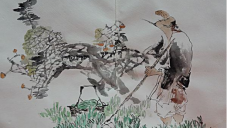
The tools used in traditional Chinese painting are paintbrush, ink, traditional paint and special paper or silk. It developed and was classified by theme into three types: figures, landscapes, and birds-and-flowers.
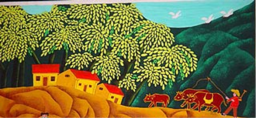

The birds-and-flowers type has its roots in the decorative patterns engraved on pottery and bronze ware by early artists. Among the common subjects in this genre, which reached its peak during the Song Dynasty (960 - 1279), are flowers, bamboo, birds, insects, and stones. The genre flourished under Emperor Huizong (1082 - 1135), who was an artist himself and was good at both calligraphy and traditional painting, especially paintings of exquisite flowers and birds.
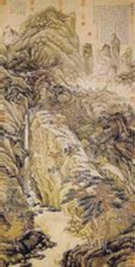
Painters who specialized in figures included images of immortals, emperors, court ladies, and common people in their works. Through their depictions of such scenes and activities as feasts, worship and street scenes, these artists reflected the appearance, expressions, ideals, and religious beliefs of the people. Chinese figure painting prominently features verve. The portrait of figures saw its peak during the Tang Dynasty (618 - 907). The master of painting, Wu Daozi (about 685 - 758), created many Buddhist murals and other landscape paintings that are marked by variety and vigor. One of his best known works is a depiction of the Heaven King holding his newborn son Sakyamuni to receive the worship of the immortals.
As far back as the Northern and Southern Dynasties (386 - 589), landscape painting separated from the figure genre and continued to enjoy popularity through the Tang Dynasty. This style reflected people’s fondness for nature. The artist’s use of ink and brush to paint a landscape changed, depending on the scenery itself, the weather (sunny or rainy day), the time of day (morning or night), and the season. The earliest known landscape painting was the Spring Outing by Zhan Ziqian of the Sui Dynasty (581 - 618). It shows an enchanting spring scene with people enjoying popular activities: gentlemen riding and ladies boating. A waterfall behind a bridge, near slopes and distant mountains are drawn with clear, fluent lines.
During the Ming (1368 - 1644) and Qing (1644 - 1911) Dynasties, innovation was stressed, and delicate seal marks, calligraphy, poems and frames increased the elegance and beauty of the paintings.
Much skill is required of the Chinese painter, who must use the soft brush with strength and dexterity to create a wide variety of lines-thick, thin, dense, light, long, short, dry, wet, etc. Depending on his skills, he might specialize in detailed and delicate line drawing (Gongbi) or abstract, impressionistic (Xieyi) paintings. Line drawing is the basic training of a painter, who must learn it well before moving on to the delicate details of realistic scenes or the more abstract spirit of impressionism. Another special skill worthy of mention is painting with fingers instead of a brush, which creates a very different effect.
No matter what the subject or the style, traditional Chinese painting should be filled with imagination and soul. A traditional story that captures the Chinese view of painting tells about the establishment of a royal college of painting during the reign of Emperor Huizong. Examinations were held to recruit the best painters. Examinees were asked to draw a picture that reflected the joy of people who had just returned from a spring outing, an outing that had been so pleasant that even the horseshoes seemed fragrant. Many tried their best to describe this bright scene but only one work was chosen; the painter simply drew a horse’s hoof followed by butterflies which were in graceful flight. This painter had managed to capture the essential spirit and beauty of the scene. (615 words)
1. How many types can Chinese painting be divided into according its theme?2. When did landscape painting separated from the figure genre (人物题材)?

Magic goes against the rules of nature and physics. During the 2009 CCTV Spring Festival gala, magician Liu Qian managed to drop a coin into a glass placed upside down and transformed a finger ring into an unbroken egg, under the close and watchful eyes of the studio audience, leaving tens of thousands of viewers puzzled by his showmanship.
The mind-blowing performance has set off an enthusiasm of magic all over the country. However, people seldom know that more than 3,600 years ago, the history of magic in China was already underway.
In China, magic goes back many years and has developed from superstitious wizardry into a technologically inspired, sophisticated art form.
Ancient Chinese magic made its appearance as early as 1,600 BC, and was closely associated with divination and wizardry, according to Biographies of Exemplary Women (Lie Nu Zhuan) by Liu Xiang, the well-known historian of the Han Dynasty (206 BC-AD 220).

In 108 BC, Liu Che, emperor of the Western Han Dynasty, gathered more than a hundred acrobats and magicians in the imperial palace and hosted the biggest magic show in history. Zhang Heng’s Western Metropolis Rhapsody (Xi Jing Fu西京赋) records that Duke Huang of the Eastern Sea (Donghai Huanggong), a showman and magician, did knife-swallowing and fire-spitting shows at this gathering.
Magic continued to thrive in the Tang Dynasty (AD 618-907) and began to branch off into separate fields in the Song Dynasty (960-1279). Some traditional Chinese tricks such as “Immortal Plants Bean” and “Ancient Color Trick” marked the start of international recognition for Chinese magic.
In the late Qing Dynasty (1644-1911), there were many cultural exchanges between China and the West. The first generation of modern Chinese magicians like Ching Ling Foo (Zhu Liankui), Han Pingchien and Mu Wenqing went abroad to perform and also learned to incorporate foreign stunts into traditional tricks.
The later generation of magic practitioners, headed by Zhang Huichong, furthered the hybrid form of magic acts by infusing traditional Chinese magic into Western-style illusion acts.
After China’s reform and opening-up in the late 1970s, magicians from abroad began visiting China more frequently. In 1980, Marc Wilson from the United States became the first magician to perform on the Chinese mainland since the founding of New China in 1949. In 2002, David Copperfield caused a stir with his performances of walking through the Great Wall.
And now, Liu Qian has created a hit with his remarkable close-up performances and exposed Chinese audiences to a new, refreshing and delightful art form.
1. How long is it since magic in China appeared?2. When did magicians from abroad begin visiting China more often?
3. Who was it that wrote a book recording knife-swallowing and fire-spitting shows?
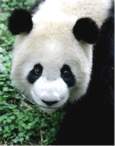
The giant panda is one of the most popular animals in the world. A giant panda can grow up to 1.5 meters long and weigh up to 160kg. People think the giant panda is very lovely. ①So it is not surprising that the World Wide Fund for Nature chose the giant panda as its symbol. The WWF tells people about animals that they are in danger and raises money to save them.
The giant panda only lives in the wild in China. In the early 1980s, were only 1,000 left in the wild. The main reason why pandas are endangered is that the area where pandas can live has become smaller.
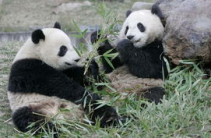
The WWF works to help giant pandas in the wild in many ways. One of the ways that helps them is to increase the size of panda reserves. Some reserves need to be joined together by planting bamboo between them to make “corridors”. These are paths that lead from one reserve to another. No one may harm the pandas in these areas. The corridors let pandas move from one habitat to another to look for food. ②People are working very hard to make sure the giant panda does not die out. (213 words)
1. How long and heavy can a giant panda grow to be?2. 将文中划线的句子①改为被动句。
So it is not surprising that
3. Why are the giant pandas endangered?
4. Give a way to help the giant pandas in the wild, please.
5. 将文中划线的句子②翻译成中文。
“When a guest comes to my home from afar on a cold night, I light bamboo to boil tea to offer him.” — Ancient Chinese poem.
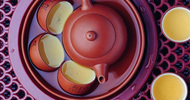
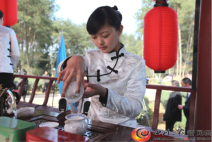

China is the home country of tea. Before the Tang Dynasty, Chinese tea was exported by land and sea, first to Japan and Korea, then to India and Central Asia and, in the Ming and Qing dynasties, to the Arabian Peninsula. In the early period of the 17th century, Chinese tea was exported to Europe, where the upper class adopted the fashion of drinking tea. Chinese tea—like Chinese silk and china—has become synonymous worldwide with refined culture. At the heart of the art of tea—the study and practice of tea in all its aspects—is the simple gesture of offering a cup of tea to a guest that for Chinese people today is a fundamental social custom, as it has been for centuries. China traces the development of tea as an art form to Lu Yu, known as “the Saint of Tea” in Chinese history, who lived during the Tang Dynasty and who wrote The Book of Tea, the first ever treatise on tea and tea culture. The spirit of tea permeates Chinese culture, and throughout the country there are many kinds of teas, teahouses, tea legends, tea artifacts and tea customs. Better-known places to enjoy a good cup of tea in China include Beijing noted for its variety of teahouses; Fujian and Guangdong provinces and other places in the southeast of China that serve gongfu tea, a formal serving of tea in tiny cups; the West Lake in Hangzhou, also the home of the Tea Connoisseurs Association, noted for its excellent green tea; and provinces in southwest China like Yunnan where the ethnic groups less affected by foreign cultures keep tea ceremonies and customs in original tea-growing areas. (307 words)
1. How was Chinese tea exported to foreign countries before the Tang Dynasty?2. How much do you know about gongfu tea? Please share your knowledge about gongfu tea with your partner.
People in different parts of China have different ways to celebrate the Mid-Autumn Festival. But one traditional custom has definitely remained and is shared by all the Chinese. This is eating the festive specialty: cakes shaped like the moon.
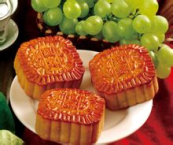
Moon Cake is the food appearing everywhere at any celebration of this traditional festival, not only because of its delicious taste and charming looking, but also for the cultural and artistic connotation. Nowadays, moon cakes with their various flavors and delicate packaging actually have become a kind of artwork. People can also get artistic pleasure while enjoying the food.
Moon cakes are round pastries that are about an inch in height. Inside, they are filled with lotus seeds, red bean paste, orange peel, melon seeds, ham, dried flower petals, and salted duck’s egg yolk. The surface of the food is patterned with clouds, the moon, and the rabbit.
It symbolizes the reunions of families and couples. The exchanging of gifts during the mid autumn festival is one of the hospitable custom and lovers would also give moon cakes as presents to show their passions.
The custom of eating moon cakes can date back to thousand of years ago, having a close relationship with Chinese culture and history. In Chinese ancient literary history, a considerable number of poets and intellectuals created many classic poems and articles about the Mid-Autumn Festival and Moon Cakes. In Chinese fairy tales, there lived on the moon the fairy Chang'er, a wood cutter named Wu Gang and a jade rabbit which is Chang’er’s pet. In the old days, people paid respect to the fairy Chang’er on the Mid-Autumn Festival.
1. What does the moon cake stand for in Chinese culture?2. Describe what does the moon cake look like?



